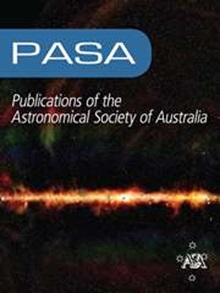Deep learning for morphological identification of extended radio galaxies using weak labels
IF 4.6
3区 物理与天体物理
Q1 ASTRONOMY & ASTROPHYSICS
Publications of the Astronomical Society of Australia
Pub Date : 2023-08-09
DOI:10.1017/pasa.2023.46
引用次数: 0
Abstract
Abstract The present work discusses the use of a weakly-supervised deep learning algorithm that reduces the cost of labelling pixel-level masks for complex radio galaxies with multiple components. The algorithm is trained on weak class-level labels of radio galaxies to get class activation maps (CAMs). The CAMs are further refined using an inter-pixel relations network (IRNet) to get instance segmentation masks over radio galaxies and the positions of their infrared hosts. We use data from the Australian Square Kilometre Array Pathfinder (ASKAP) telescope, specifically the Evolutionary Map of the Universe (EMU) Pilot Survey, which covered a sky area of 270 square degrees with an RMS sensitivity of 25–35 $\mu$ Jy beam $^{-1}$ . We demonstrate that weakly-supervised deep learning algorithms can achieve high accuracy in predicting pixel-level information, including masks for the extended radio emission encapsulating all galaxy components and the positions of the infrared host galaxies. We evaluate the performance of our method using mean Average Precision (mAP) across multiple classes at a standard intersection over union (IoU) threshold of 0.5. We show that the model achieves a mAP $_{50}$ of 67.5% and 76.8% for radio masks and infrared host positions, respectively. The network architecture can be found at the following link: https://github.com/Nikhel1/Gal-CAM基于弱标签的扩展射电星系形态识别的深度学习
摘要:本文讨论了一种弱监督深度学习算法的使用,该算法可以降低具有多个组件的复杂射电星系的像素级掩模标记成本。该算法在射电星系的弱类级标签上进行训练,得到类激活图(CAMs)。使用像素间关系网络(IRNet)进一步改进cam,以获得射电星系及其红外宿主位置的实例分割掩模。我们使用的数据来自澳大利亚平方公里阵列探路者(ASKAP)望远镜,特别是宇宙进化图(EMU)试点调查,覆盖了270平方度的天空区域,RMS灵敏度为25-35 $\mu$ Jy光束$^{-1}$。我们证明了弱监督深度学习算法可以在预测像素级信息方面实现高精度,包括封装所有星系成分的扩展无线电发射掩模和红外宿主星系的位置。我们在标准交集超过联合(IoU)阈值为0.5的情况下,使用跨多个类的平均平均精度(mAP)来评估我们方法的性能。结果表明,该模型对射频掩模和红外主机位置的mAP $_{50}$分别达到了67.5%和76.8%。网络架构可在以下链接找到:https://github.com/Nikhel1/Gal-CAM
本文章由计算机程序翻译,如有差异,请以英文原文为准。
求助全文
约1分钟内获得全文
求助全文
来源期刊
CiteScore
5.90
自引率
9.50%
发文量
41
审稿时长
>12 weeks
期刊介绍:
Publications of the Astronomical Society of Australia (PASA) publishes new and significant research in astronomy and astrophysics. PASA covers a wide range of topics within astronomy, including multi-wavelength observations, theoretical modelling, computational astronomy and visualisation. PASA also maintains its heritage of publishing results on southern hemisphere astronomy and on astronomy with Australian facilities.
PASA publishes research papers, review papers and special series on topical issues, making use of expert international reviewers and an experienced Editorial Board. As an electronic-only journal, PASA publishes paper by paper, ensuring a rapid publication rate. There are no page charges. PASA''s Editorial Board approve a certain number of papers per year to be published Open Access without a publication fee.

 求助内容:
求助内容: 应助结果提醒方式:
应助结果提醒方式:


